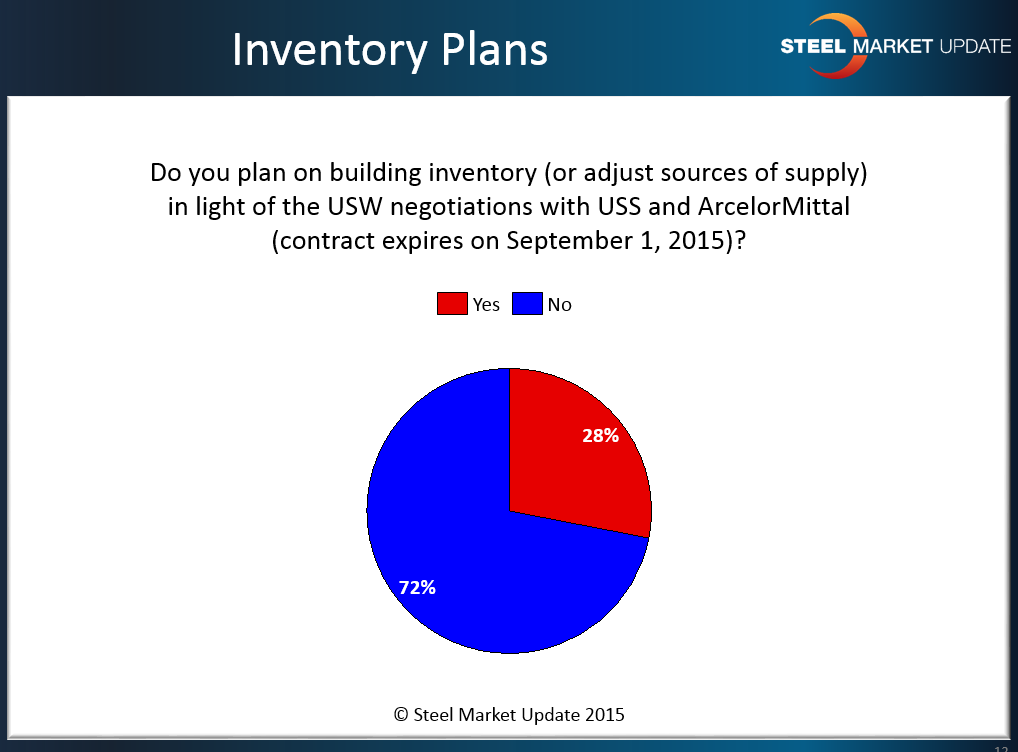SMU Data and Models

USW, US Steel & ArcelorMittal Negotiations Are You Preparing?
Written by John Packard
June 18, 2015
Steel Market Update reported in the Tuesday issue of our newsletter that negotiations have started between the USW (United Steelworkers Union) and ArcelorMittal.
The issue was raised at the Bank of America Merrill Lynch dinner where SMU publisher, John Packard, spoke last night. We have been anticipating that the posturing by the union and AM, as well as US Steel, will be one of the main topics of the summer. This is indeed the case.
We asked our survey respondents, “Do you plan on building inventory (or adjust sources of supply) in light of the USW negotiations with USS and ArcelorMittal (contract expires on September 1, 2015)?”
Thirty-one percent (31%) of our respondents reported that they would be building inventory and/or adjusting sources of supply in order to protect their businesses. This leaves a full 71 percent who are comfortable with their current situation and supply sources.
This was another question where the respondents chose to leave comments regarding the question or their response:
“We are considering a slight building of inventory. But we are closely watching the UAW/Automaker negotiations as this has an impact on price/availability as well.” Manufacturing company
“Inventory build yes source adjustment no.” Service center
“We will build inventory for our OEM customer base.” Service center
“We are looking at alternative sources for the items purchased from USS and AM. “ Service center
“There will be some areas I’m sure where we build a small bank but based on the strength of our relationship with Arcelor, we will work together so our customers are protected.” Service center
“Not expecting a strike. Lots of posturing but too much red ink at Steelmakers my bigger concern is the UAW.” Service center

John Packard
Read more from John PackardLatest in SMU Data and Models

SMU Scrap Survey: Sentiment Indices rise
Both current and future scrap sentiment jumped this month, though survey participants reported responses before key trade news was announced.

SMU Survey: Sentiment splits, buyers have better view of future than the present
SMU’s Steel Buyers’ Sentiment Indices moved in opposite directions this week. After rebounding from a near five-year low in late June, Current Sentiment slipped again. At the same time, Future Sentiment climbed to a four-month high. Both indices continue to show optimism among buyers about their company’s chances for success, but suggest there is less confidence in that optimism than earlier in the year.

SMU scrap market survey results now available
SMU’s ferrous scrap market survey results are now available on our website to all premium members. After logging in at steelmarketupdate.com, visit the pricing and analysis tab and look under the “survey results” section for “ferrous scrap survey” results. Past scrap survey results are also available under that selection. If you need help accessing the survey results […]

SMU flat-rolled market survey results now available
SMU’s latest steel buyers market survey results are now available on our website to all premium members. After logging in at steelmarketupdate.com, visit the pricing and analysis tab and look under the “survey results” section for “latest survey results.” Past survey results are also available under that selection. If you need help accessing the survey results, or if […]

SMU Survey: Sheet lead times stabilize, plate contracts
Mill lead times for sheet products were steady to slightly longer this week compared to our late June market check, while plate lead times contracted, according to steel buyers responding to this week’s market survey.

